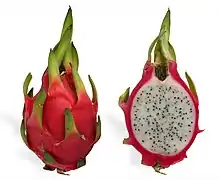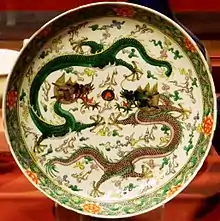แก้วมังกร
Thai

the fruit

dragons disputing over a pearl
Etymology
From แก้ว (gɛ̂ɛo, “any clear, transparent substance, as glass, crystal, pearl, etc”) + มังกร (mang-gɔɔn, “dragon”); coined in 1998 by Kasetsart University lecturer Suraphong Kosiyachinda (สุรพงษ์ โกสิยะจินดา) as a calque of English dragon fruit[1] and perhaps from the fact that the fruit looks like the dragon's pearl in Chinese mythology.
Pronunciation
| Orthographic | แก้วมังกร æ k ˆ w m ạ ŋ k r | |
| Phonemic | แก้ว-มัง-กอน æ k ˆ w – m ạ ŋ – k ɒ n | |
| Romanization | Paiboon | gɛ̂ɛo-mang-gɔɔn |
| Royal Institute | kaeo-mang-kon | |
| (standard) IPA(key) | /kɛːw˥˩.maŋ˧.kɔːn˧/(R) | |
This article is issued from Wiktionary. The text is licensed under Creative Commons - Attribution - Sharealike. Additional terms may apply for the media files.